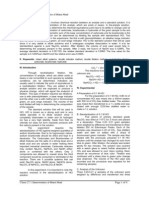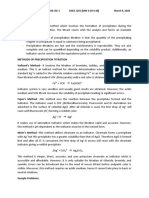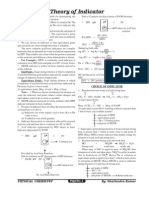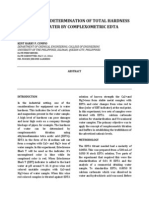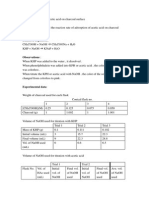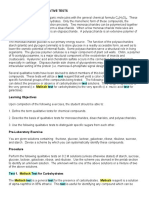Experiment 3
Experiment 3
Uploaded by
Stephanie Ann Marie DueñasCopyright:
Available Formats
Experiment 3
Experiment 3
Uploaded by
Stephanie Ann Marie DueñasOriginal Description:
Copyright
Available Formats
Share this document
Did you find this document useful?
Is this content inappropriate?
Copyright:
Available Formats
Experiment 3
Experiment 3
Uploaded by
Stephanie Ann Marie DueñasCopyright:
Available Formats
Experiment 3 Determination of Mixed Alkali
LOGRONIO, Alvin J. PAYNAGANAN, Renlyn Ivy DG.
Group 1, Chem 27.1 TEJ, Ms. Jireh Joy E. Sacramento
February 21, 2012
I. Abstract
This determination of mixed alkali focused on the application of the acid-base titration in the
determination of the composition of alkali mixtures of bases, such as carbonate or bicarbonate, either alone or in
combination in a solution. This method is used for the determination of the safeness of water for irrigation and
the determination of the buffer capacity of natural waters. In the process, the unknown is titrated with a
hydrochloric acid solution, which was standardized by titration with a sodium carbonate primary standard. Then,
the two-indicator method was used, with phenolphthalein and bromocresol green as indicators. The said method
aimed to determine the two endpoints typically shown by the polyfunctional carbonate base, if applicable. The
data gathered predicted the presence of NaHCO3, Na2CO3 or NaOH and their percent composition in the
unknown. For a double-indicator method, the amount of carbonate and hydroxide present is taken from the
amount of hydrochloric acid required to reach the phenolphthalein end point. While the amount of bicarbonate
present is found by the amount needed to reach the bromocresol green end point.
II. Keywords
acid-base titration, mixed alkali, standardization, two-indicator method, carbonate, bicarbonate
III. Introduction given sample using a two-indicator neutralization
Alkalimetry is a specialized analytic use of titration with a standardized HCl solution as the titrant.
acid-base titration to determine the concentration of a
base. It also involves the determination of the quantity IV. Experimental
of real alkaline in alkali solutions or salts, either The standard HCl solution required in the
through gravimetric or volumetric analysis. experiment was prepared by diluting 8.23 mL of the
Carbonates and bicarbonates of alkali concentrated HCl solution in sufficient amounts of CO 2
mixtures are important industrial chemicals since they free distilled water to make a 1 liter solution. Three
are the salts of a strong base and a weak acid and are 0.20-0.21 g samples of the dried standard Na 2CO3
only readily available salts of these anions that are was transferred to three numbered 250 mL flasks
soluble in water. Presence of these compounds may where 250 mL of CO2 free distilled water and 2 drops
occur in different combinations that can be identified of bromocresol green indicator was added. These
using titrations that involve neutralization reactions three samples was then titrated with the 0.1 M HCl
with strong acids. solution until the color changed from yellow to light
The carbonates and bicarbonates in the blue. When the color changed, the solution was then
solution can be present in the forms CO 32-, HCO3- and boiled for 2 minutes and the flask was then covered
OH-. Neutralization titrations are employed in the with a watch glass or inverted beaker to retard the
quantitative determination of the constituents of a absorption of CO2 and allow the solution to cool. After
mixed alkali solution. Two methods can be used to cooling, the solution was supposed to return into its
determine a mixture of bases by titration: the two- yellow color. The titration was then continued until the
titration method and the two-indicator titration method. yellow color was changed into a distinct blue color.
In our experiment, we used the two-indicator method The molarity was computed and noted for future
to determine the carbonate and bicarbonate mixtures computations.
in the unknown. The two volumes of the endpoints of Three 0.20-0.21g samples was weighed by
the two indicators used will help in determining the difference into three 250mL Erlenmeyer flasks. 25 mL
carbonate and bicarbonate contents of the given of CO2 free water and 2 drops of phenolphthalein
sample. indicator was then added to the sample. The flask was
Indicators used in titrating your samples must immersed in an ice bath while it was being titrated with
be carefully chosen to be able to detect the endpoints the 0.1 M standardized HCl solution. The solution was
of the neutralization reactions employed in the slowly titrated with constant vigorous swirling until the
experiment. In this two-indicator titration, pink color just disappeared. The volume was then
phenolphthalein and bromocresol green was used. recorded on the table provided.
Phenolphthalein was used in titrating Na2CO3, while The titrated solution was removed from the ice bath
bromocresol green was used in titrating NaHCO3. and 2 drops of bromocresol green indicator was
The aim of this experiment is to determine added. It was then titrated once more with the 0.1 M
carbonate and bicarbonate mixtures present in the standardized HCl solution until the yellow color just
Chemistry 27.1 Determination of Mixed Alkali Page 1 of 4
turned into a distinct light blue color. The second Sodium carbonate (Na2CO3) is the most common
volume was also recorded in the table. reagent used for standardization of acid solutions and
is readily available in the primary standard grade,
V. Results which is recommended for higher accuracy. Since this
Table 1. Standardization of HCl Solution reagent is hygroscopic, it is necessary to dry it in an
Weight of Volume of Molarity of oven before weighing in order to achieve a uniform
Trial
Na2CO3 (g) HCl (mL) HCl (M) and reproducible composition. It can be cooled and
1 0.2085 38.2 0.103 stored in a desiccator, which contains desiccants that
2 0.2082 42.7 0.092 absorb moisture, to prevent any absorption by the
3 0.2057 39.0 0.0995 reagent.
Average Molarity of HCl (M): 0.0982 It must be noted that before weighing any
reagents that are previously heated, they must be
Sample Computations: cooled to room temperature. This is because, inside
the analytical balance, any heat transfer from the
1mol Na2CO3 2 mol HCl reagent to the air can cause the production of air
0.2085gNa2CO3
105.99 g 1mol Na2CO3 currents, which results in erroneous measurements.
0.103M HCl Also, weighing must be done by difference since it
0.0382 L solution
gives more accurate measurements, and also the
Table 2. Analysis of Unknown
closed interior of the analytical balance prevents any
mL HCl mL HCl Na2CO3 NaHCO3 moisture absorption on the reagent.
Trial After weighing, the primary standard Na 2CO3 can
(ph) (bcg) M %(w/v) M %(w/v)
1 9.1 9.4 0.036 0.38% - - then be titrated by the HCl titrant by either
2 9.1 9.5 0.036 0.38% - - phenolphthalein (ph), forming HCO 3- or by
Ave. % (w/w) Na2CO3 in the sample 0.38 %
bromocresol green (bcg), forming carbonic acid
Ave. % (w/w) NaHCO3 in the sample -
(H2CO3). The latter is preferred due to the formation of
a larger pH break, reducing indicator error, and a
Sample Computations:
larger volume of titrant, reducing the relative error in
measurement. After standardization, the HCl titrant
0.0982 mmol HCl 1mmol CO32 can be used to determine unknown mixtures.
9.1mL HCl
mL 1mmol HCl In the determination of carbonate, bicarbonate
1mmol Na2CO3 1 and hydroxide mixtures, it must be noted that HCO 3-
2
0.0357 M Na2CO3 and OH- cannot coexist together since they react to
1mmol CO3 25mL solution
form CO32-.
0.0357mol Na2CO3 1L 105.99 g HCO3- + OH- -> CO32- + H2O
100 0.378%
L 1000 mL 1mol Na2CO3
From this, we can also say that the three
VI. Discussion constituents cannot coexist together because of the
Determination of carbonates (CO32-), previous reaction, resulting in CO32- and the excess
- -
bicarbonates (HCO3 ) and hydroxides (OH ) in a basic between HCO3- and OH- to be in solution. The five
mixture involves the titration of the mixture with a possible combinations, considering the above
strong acid using either a two-indicator method or a conditions are: CO32-, CO32-/OH-, CO32-/ HCO3-, OH-
two-titration method. In the two-indicator method, one and HCO3-.
titration set-up is used for the determination of two This determination involves the titration of the
equivalence points. After the first endpoint has been unknown with the HCl titrant. The indicators used for
detected using an indicator, another indicator is added this experiment are phenolphthalein (pKa = 9.3), which
to the analyte in order to detect the second endpoint. detects the endpoint of the first titration of CO 32- to
In the two-titration method, two titration set-ups are HCO3-, and bromocresol green (pK a = 4.8), which
used. For each set up, an endpoint is detected using detects the endpoint for the second titration of HCO 3-
its corresponding indicator. to H2CO3. Both of these indicators are chosen since
For this experiment, hydrochloric acid (HCl) was their indicator range (ph: 8.3-10 bcg: 3.8-5.4)
used as the titrant, since, like other strong acids, it coincides well with the pH break they detect. (pH
gives a large Ka in titration. Also, its dilute solutions are break for CO32- to HCO3- 7-10; pH break for HCO 3-
stable, it has very lttle oxidizing or reducing power, to H2CO3 2-6) There is a third pH break for titration
plus the chloride ion does not precipitate with most of OH- to H2O (around pH 11.34) but it is too small to
cations. The drawback for HCl is that it is not a be properly detected by any indicator.
primary standard and must be standardized to
determine its exact concentration.
Chemistry 27.1 Determination of Mixed Alkali Page 2 of 4
yellow to a blue color in solution and H 2CO3 will
predominate and will decompose into CO2 and H2O.
When the endpoint is reached, boiling the solution
would remove produced and dissolved CO2,
ph enhancing the sharpness of the pH break. This also
removes the buffer produced by H2CO3 and HCO3-,
preventing the slow change in pH. If the solution
remained blue, then the endpoint has been detected,
bcg but if the solution becomes yellow, the solution is
cooled. Temperature changes the equilibrium
constant, and therefore the equivalence point so it is
important to cool the solution first before continuing
titration in order to obtain the proper equivalence
Figure 1. Titration curve of CO32-, with HCl, showing indicator ranges
point. Not doing this leads to an error. After cooling,
of phenolphthalein and bromocresol green the analyte is titrated further until endpoint.
The constituents present in the solution can be
In the first titration reaction: determined based on the relative volumes of acid
used in the titration of the mixture. After confirming the
HCl(aq) + Na2CO3(aq) -> NaHCO3(aq) + H2O(l) presence of the species, the concentration of the
respective components can be known from the
the analyte is expected to become colorless from a amounts of acid consumed. Figure 3 summarizes the
pink color and HCO3- will predominate in the solution. volume relationships in the analysis of mixtures
This reaction is a neutralization reaction and therefore, containing hydroxide, carbonate, and hydrogen
is exothermic. Also, the solubility of the carbon dioxide carbonate ions.
(CO2) gas formed by CO32- is higher at low
temperature. From these statements, titration inside Relationship between Vph
and Vbcg in the Titration of
an ice bath is recommended. This would not only push Constituents in Sample
an Equal Volume of
the equilibrium forward, making a higher pH break, but Sample
also prevent a decrease in CO32- concentration. NaOH Vph > 0 Vbcg = 0
Na2CO3 Vph = Vbcg
H2CO3(aq) + H2O(l) + CO2(g) NaHCO3 Vph = 0; Vbcg > 0
NaOH, Na2CO3 Vph > Vbcg
Na2CO3, NaHCO3 Vph < Vbcg
Figure 3. Volume relationships in the analysis of mixtures containing
hydroxide, carbonate or hydrogen carbonate Ions for a double-
indicator method
It is important that for the whole experiment, only
CO2-free distilled water must be used since dissolved
CO2 in water produces carbonic acid, which
dissociates, producing CO32- as one of its products.
H2O(l) + CO2(g) -> H2CO3(aq)
bcg
This would give a positive error to the final
amount of CO32- determined. CO2-free distilled water
prevents that problem. Also, to prevent any CO 2 to be
dissolved in the solution all containers must be sealed
at all times.
Even though we employ methods to prevent CO 2
Figure 2. Titration curve of CO32-, with HCl, showing the effect of
boiling the solution before second equivalence point
gain or CO2 loss, we cannot fully protect the solution
from the atmosphere, giving a positive error, and we
The second titration reaction: cannot fully prevent the loss of dissolved CO 2 resulting
in a negative error.
HCl(aq) + NaHCO3(aq) -> NaCl(aq) + CO2(aq) + H2O(l) Another error would be the misreading of the
color change at endpoint, along with the indicator error
which is also the titration reaction for the produced by the indicators, which both indicator
standardization reaction is expected to change from a ranges border the pH breaks they detect. Also,
Chemistry 27.1 Determination of Mixed Alkali Page 3 of 4
a wrong amount of indicator can be a cause for error Hargis, L. G. (1988). Analytical chemistry: principles
because indicators also contribute to the pH of the and techniques. NJ, USA: Prentice Hall.
solutions since they are also acidic or basic.
Another important point is that both calculations
of amount of carbonate and hydroxide are based on We hereby certify that we have given substantial
two measurements, which means final error can be contribution to this report.
twice as large as in the case of simple titration with
one end point.
The error that is produced from the
standardization of HCl is carried over to the
determination of unknown, stacking to the final error LOGRONIO, Alvin J.
obtained. Air locks that are hidden, or produced during
titrations is also a source of error. Error that is
obtained from not fully transferring 100% of the solids
or liquids to other containers is very common.
Accidental spills and leaks from burettes, even in a PAYNAGANAN, Renlyn Ivy D.G.
small amount can cause errors in the final values
obtained. Many more sources of error can be
obtained, so it is very important to be careful when
doing the experiment, in order to prevent them.
VII. Conclusions and Recommendations
Determination of mixed alkali is done through
acid-base titration of an unknown alkali mixture, such
as a carbonate and bicarbonate mixture, with a
standardized acid titrant such as hydrochloric acid.
This standardization is done through the titration of a
primary standard analyte, such as sodium carbonate
with the acid titrant in order to determine its
concentration. An unknown is then titrated against the
acid titrant with two indicators either on one setup or
on different ones to obtain the volume needed in order
to reach each of the equivalence points for the base.
These volumes would then determine what the
components of the mixture are and how much of each
component is in the mixture.
The final value for this experiment has a relative
error of around 3% compared to the theoretical data.
This error can be minimized by better controlling
the environment to prevent CO2 loss or addition or by
changing bromocresol green to methyl orange since
its pKa (3.47) is nearer to the pH at equivalence point
(4.03) compared to bromocresol green (4.8) and
would give a lower indicator error.
VIII. References
ChemBuddy. (2009, September 6). Warder titration -
simultaneous determination of sodium hydroxide
and carbonate. Retrieved from:
http://www.titrations.info/acid-base-titration-
sodium-hydroxide-and-carbonate
ChemBuddy. (2011, May 25). Titration and titrimetric
methods - sources of errors. Retrieved from:
http://www.titrations.info/titration-errors
Chemistry 27.1 Determination of Mixed Alkali Page 4 of 4
You might also like
- Gravimetric Determination of Moisture CoDocument5 pagesGravimetric Determination of Moisture CoDEFIN BIMA REYNANDANo ratings yet
- Lab 2Document15 pagesLab 2api-3868874100% (3)
- Experiment Report: Spectrophotometric Analysis of Caffeine and Benzoic Acid in Soft DrinkDocument12 pagesExperiment Report: Spectrophotometric Analysis of Caffeine and Benzoic Acid in Soft DrinkNitty MeYaNo ratings yet
- Effective Sandstone Acidizing - Best PracticeDocument17 pagesEffective Sandstone Acidizing - Best Practicemahimoh18100% (4)
- PREPARATION AND STANDARDIZATION OF HCL SOLUTION WITH PRIMARY STANDARD Na CO SOLUTION (CHM256)Document10 pagesPREPARATION AND STANDARDIZATION OF HCL SOLUTION WITH PRIMARY STANDARD Na CO SOLUTION (CHM256)maisarah20salwaNo ratings yet
- Experiment 3 - Determination of Mixed AlkaliDocument2 pagesExperiment 3 - Determination of Mixed AlkaliPeter BrayNo ratings yet
- Determination of Mixed AlkaliDocument4 pagesDetermination of Mixed AlkaliArianne Balaoing100% (1)
- Measurement of The Gas Constant and Molar Volume of Oxygen GasDocument12 pagesMeasurement of The Gas Constant and Molar Volume of Oxygen GasJennifer Im0% (1)
- Chem 32 3rd Lec ExamDocument5 pagesChem 32 3rd Lec ExamJohn Michael CueNo ratings yet
- Precipitation TitrationDocument3 pagesPrecipitation TitrationBanana SenpaiNo ratings yet
- Determination of Chloride by Volhard and Mohr MethodDocument6 pagesDetermination of Chloride by Volhard and Mohr MethodShane AmolarNo ratings yet
- Potentiometric Determination of The Ionization Constant of A Pure Unknown Weak AcidDocument3 pagesPotentiometric Determination of The Ionization Constant of A Pure Unknown Weak AcidDozdi100% (3)
- Determinate of The Concentration of Acetic Acid in VinegarDocument22 pagesDeterminate of The Concentration of Acetic Acid in VinegarSYahira HAzwaniNo ratings yet
- Precipitation TitrationDocument19 pagesPrecipitation TitrationRoj Waleed BarwaryiNo ratings yet
- Precipitation Titration 1Document25 pagesPrecipitation Titration 1Beyond LbbNo ratings yet
- Precipitation TitrationsDocument3 pagesPrecipitation Titrationshun8866No ratings yet
- Iodine Clock ReactionDocument6 pagesIodine Clock Reactionapi-271065755No ratings yet
- Formal Report 1 Expt 7 Chem 26.1Document6 pagesFormal Report 1 Expt 7 Chem 26.1Franz Valencia100% (1)
- Experiment #5 Analysis of Acetic Acid: September 8, 2016 Prof. Jeanne Grace AberionDocument33 pagesExperiment #5 Analysis of Acetic Acid: September 8, 2016 Prof. Jeanne Grace AberionShiennah Joy Linguete EupeñaNo ratings yet
- Review For Ana ChemDocument5 pagesReview For Ana ChemRyle ArbonNo ratings yet
- Spectrophotometric Determination of The Acid Dissociation Constant of Methyl RedDocument3 pagesSpectrophotometric Determination of The Acid Dissociation Constant of Methyl Red7063673nasNo ratings yet
- Practical Chemistry Voumetric EstimationDocument9 pagesPractical Chemistry Voumetric EstimationSanjay Shirodkar100% (3)
- Chloride MohrDocument2 pagesChloride MohrHasan Abuy100% (1)
- Antacid Analysisrty4Document4 pagesAntacid Analysisrty4Melced BenasasNo ratings yet
- Experiment 3Document14 pagesExperiment 3hasmar78% (27)
- Triiodide Ion: Determination of An Equilibrium ConstantDocument5 pagesTriiodide Ion: Determination of An Equilibrium ConstantJericho LakampuengaNo ratings yet
- Indirect Titration MethodDocument2 pagesIndirect Titration MethodparisdelapenaNo ratings yet
- Double Indicator TheoryDocument3 pagesDouble Indicator TheoryIrfan NunkooNo ratings yet
- Double Indicator Titration ExercisesDocument1 pageDouble Indicator Titration ExercisesBenjamin Wong100% (1)
- Chemistry 12 - Unknown Acid Base Titration LabDocument6 pagesChemistry 12 - Unknown Acid Base Titration LabarasurtNo ratings yet
- Lab 1Document4 pagesLab 1Jason Robert VictorNo ratings yet
- Asprin Lab ReportDocument10 pagesAsprin Lab ReportMohamedNo ratings yet
- Experiment 2Document8 pagesExperiment 2zidrick benjaminNo ratings yet
- Lab 1: Separation of An Unknown Mixture: ReadingDocument13 pagesLab 1: Separation of An Unknown Mixture: ReadingKharbanda AcadmeyNo ratings yet
- Complexometric EDTADocument36 pagesComplexometric EDTANqobile Nqoerh MnguniNo ratings yet
- EXP 4 Surface TensionDocument7 pagesEXP 4 Surface TensionGrace Aquino100% (1)
- Chem 26.1 Syllabus - ICDocument15 pagesChem 26.1 Syllabus - ICDoom RefugeNo ratings yet
- CHEM 355 Experiment 5 Determination of Activity Coefficients of Hydrochloric Acid SolutionsDocument5 pagesCHEM 355 Experiment 5 Determination of Activity Coefficients of Hydrochloric Acid SolutionsMuhammad Faisal100% (1)
- EDTA Titration CalculationsDocument2 pagesEDTA Titration CalculationsMuhammed IslahuddinNo ratings yet
- Back TitrationDocument2 pagesBack TitrationjohnNo ratings yet
- Determination of ChloridesDocument4 pagesDetermination of Chloridesawaaan100% (1)
- Quantitative Determination of Total Hardness in Drinking Water by Complexometric Edta TitrationDocument2 pagesQuantitative Determination of Total Hardness in Drinking Water by Complexometric Edta TitrationKeith SmithNo ratings yet
- Spectrometric Determination of The Acid Dissociation Constant of Methyl RedDocument11 pagesSpectrometric Determination of The Acid Dissociation Constant of Methyl Redエンパーラナー カイザー ニロNo ratings yet
- Adsorption of Acetic Acid On Charcoal SurfaceDocument3 pagesAdsorption of Acetic Acid On Charcoal SurfaceFrankyFan90% (10)
- Analytical ChemistryDocument95 pagesAnalytical ChemistryHugo WNo ratings yet
- Experiment #8 (Formal Report)Document5 pagesExperiment #8 (Formal Report)Nathan Veracruz100% (1)
- Formal Report Experiment 2 and 3Document5 pagesFormal Report Experiment 2 and 3Zyra Camille Giron HacheroNo ratings yet
- Exp 1 PDFDocument3 pagesExp 1 PDFwaniNo ratings yet
- Lab Report Chemical EquilibriumDocument5 pagesLab Report Chemical EquilibriumMingNo ratings yet
- Determination of Adsorption Isotherm of Acetic Acid On Activated CharcoalDocument5 pagesDetermination of Adsorption Isotherm of Acetic Acid On Activated CharcoalShashank ChandraNo ratings yet
- Titration Lab ReportDocument25 pagesTitration Lab Reportapi-428944081No ratings yet
- Acid and Base Titration Lab ReportDocument5 pagesAcid and Base Titration Lab ReportAcademic CoordinatorNo ratings yet
- Exercises Student EdDocument10 pagesExercises Student EdKukkiboNo ratings yet
- CARBOHYDRATES Qualitative TestsDocument3 pagesCARBOHYDRATES Qualitative TestsEdith BelenNo ratings yet
- Determination of Carbonate in Soda Ash by Titration With Hydrochloric AcidDocument4 pagesDetermination of Carbonate in Soda Ash by Titration With Hydrochloric AcidHanna ShairaNo ratings yet
- Lab Report chm256Document8 pagesLab Report chm256Wahida Amalin sofeaNo ratings yet
- Analysis of A Mixture of Carbonate and BicarbonateDocument2 pagesAnalysis of A Mixture of Carbonate and Bicarbonateshaermmm124No ratings yet
- Chemistry Lab 3 Final DocumentDocument12 pagesChemistry Lab 3 Final DocumentshanonintegrityNo ratings yet
- Chm256 Odl Exp 1 2 3 Lab ReportDocument18 pagesChm256 Odl Exp 1 2 3 Lab Reportmaya adamNo ratings yet
- Synthesis of Cobalt ComplexDocument6 pagesSynthesis of Cobalt ComplexRenniel Pena100% (1)
- Exp1 CH102 Ver5Document4 pagesExp1 CH102 Ver5edwalimNo ratings yet
- Geographical Features Contributing To BIODIVERSITY: Batanes, PhilippinesDocument12 pagesGeographical Features Contributing To BIODIVERSITY: Batanes, PhilippinesStephanie Ann Marie DueñasNo ratings yet
- Investigatory Project: PHYSICS 72.1 Vicuña, Katigbak, Dueñas, Betos, SarachoDocument23 pagesInvestigatory Project: PHYSICS 72.1 Vicuña, Katigbak, Dueñas, Betos, SarachoStephanie Ann Marie DueñasNo ratings yet
- KFC Morayta KFC - SM Manila 1: 1. Products 1 - ProductsDocument6 pagesKFC Morayta KFC - SM Manila 1: 1. Products 1 - ProductsStephanie Ann Marie DueñasNo ratings yet
- On Given Dates To The Same Payee: Is The Process of Creating A Plan To Spend Your MoneyDocument1 pageOn Given Dates To The Same Payee: Is The Process of Creating A Plan To Spend Your MoneyStephanie Ann Marie DueñasNo ratings yet
- Jose Rizal's TravelsDocument45 pagesJose Rizal's TravelsStephanie Ann Marie DueñasNo ratings yet
- STS SyllabusDocument12 pagesSTS SyllabusStephanie Ann Marie Dueñas100% (5)
- Introduction To Scientific and Technological ActivitiesDocument13 pagesIntroduction To Scientific and Technological ActivitiesStephanie Ann Marie DueñasNo ratings yet
- Vietnam Country Report PDFDocument30 pagesVietnam Country Report PDFStephanie Ann Marie DueñasNo ratings yet
- Analytical Chemistry (9th Ed.) - California: Brooks/Cole, Cengage LearningDocument1 pageAnalytical Chemistry (9th Ed.) - California: Brooks/Cole, Cengage LearningStephanie Ann Marie DueñasNo ratings yet
- Full Costs and Their Uses GROUP2Document15 pagesFull Costs and Their Uses GROUP2Stephanie Ann Marie DueñasNo ratings yet
- Experiment #1:: Purification of Benzoic Acid by RecrystallizationDocument51 pagesExperiment #1:: Purification of Benzoic Acid by RecrystallizationStephanie Ann Marie DueñasNo ratings yet
- 9701 s16 QP 11Document16 pages9701 s16 QP 11Tai PanNo ratings yet
- NITRATE-Ultraviolet Spectrophotometric Screening Method PDFDocument2 pagesNITRATE-Ultraviolet Spectrophotometric Screening Method PDFPaul MartinNo ratings yet
- Practical Chemistry ICSE XDocument27 pagesPractical Chemistry ICSE XjoycepeterNo ratings yet
- Part 4 - Acidizing Section 4 of 4 NasrDocument45 pagesPart 4 - Acidizing Section 4 of 4 NasrMygroup 5544100% (1)
- Ab-416 3 enDocument20 pagesAb-416 3 ensecateNo ratings yet
- 10th OBJECTIVE 2022 CHEMISTRYDocument20 pages10th OBJECTIVE 2022 CHEMISTRYVarenayam editzNo ratings yet
- Common Names of ChemicalsDocument6 pagesCommon Names of Chemicalstpplant100% (1)
- Experiment 6Document5 pagesExperiment 6Annam AsgharNo ratings yet
- w333 PH Worksheet 1Document2 pagesw333 PH Worksheet 1mariajoticaNo ratings yet
- CHAPTER XI MetallurgyDocument2 pagesCHAPTER XI MetallurgyjenerigracemNo ratings yet
- Stoichiometry Exam Level 1&2Document16 pagesStoichiometry Exam Level 1&27409 VihaanNo ratings yet
- Stenner Classic Series Installation InstructionsDocument48 pagesStenner Classic Series Installation InstructionsWattsNo ratings yet
- Acid and Bases ConceptsDocument13 pagesAcid and Bases ConceptsAnu KadyanNo ratings yet
- Analysis of A Mixture of Carbonate and BicarbonateDocument2 pagesAnalysis of A Mixture of Carbonate and BicarbonateCharles Trono RacadioNo ratings yet
- SDS - Safety Data Sheet: 1. IdentificationDocument6 pagesSDS - Safety Data Sheet: 1. IdentificationNgô TrungNo ratings yet
- Materials and Methods: Chapter-3Document8 pagesMaterials and Methods: Chapter-3javedsaqi100% (1)
- Chloride Metallurgy - Process Technology Development - : Edgar PeekDocument39 pagesChloride Metallurgy - Process Technology Development - : Edgar PeekMauricioTeranAguilarNo ratings yet
- Anthony M. Wachinski - Environmental Ion Exchange - Principles and Design-Taylor & Francis, Chapman and Hall - CRC (2016) (1) (044-093)Document50 pagesAnthony M. Wachinski - Environmental Ion Exchange - Principles and Design-Taylor & Francis, Chapman and Hall - CRC (2016) (1) (044-093)HARDY EDDISONNo ratings yet
- Class Xi PracticalsDocument15 pagesClass Xi Practicalssmudgegaming4989No ratings yet
- D 5155 - 96 - Rduxntutoty - PDFDocument5 pagesD 5155 - 96 - Rduxntutoty - PDFMaeon LaboratoriesNo ratings yet
- STP of Purified Talc BPDocument9 pagesSTP of Purified Talc BPMd. Moniruzzaman0% (1)
- Study of Adsorption Desorption Properties of A New Scale Inhibitor PackageDocument11 pagesStudy of Adsorption Desorption Properties of A New Scale Inhibitor PackageRoberta VasquesNo ratings yet
- Re - Aipmt 2015 Test Paper With Answer & Solution (Held On Saturday 25 JULY, 2015Document19 pagesRe - Aipmt 2015 Test Paper With Answer & Solution (Held On Saturday 25 JULY, 2015Jessica ShamoonNo ratings yet
- Chem11th Ncert Solutions MergedDocument354 pagesChem11th Ncert Solutions MergedRameshwer KambleNo ratings yet
- Chem 44.1 Special SynthesisDocument86 pagesChem 44.1 Special SynthesisCarlo Joseph Moskito100% (3)
- Chemistry 1Document15 pagesChemistry 1bharat4652No ratings yet
- Chemistry: Edexcel GCEDocument24 pagesChemistry: Edexcel GCEaquu174015100% (1)
- 10th Acid Base and Salt 2 and Marks Question Answers 2011Document3 pages10th Acid Base and Salt 2 and Marks Question Answers 2011Shubham TiwariNo ratings yet
- 4.5 Answers To ExercisesDocument4 pages4.5 Answers To ExercisesrushdiNo ratings yet






